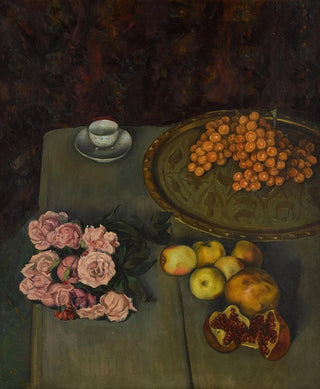Art print | Still life with roses and fruits - Émile Bernard Source: Reproduction | Nature morte aux roses et aux fruits - Émile Bernard


View from behind

Frame (optional)
"Nature morte aux roses et aux fruits" by Émile Bernard is part of a rich artistic tradition where still life becomes a reflection of emotions and sensations. Through a delicate composition, Bernard manages to capture the very essence of ephemeral beauty. The roses, symbols of love and passion, blend harmoniously with the fruits, evoking nature's generosity. This painting is not limited to a simple depiction of inanimate objects; it invites the viewer to a deep contemplation, an immersion into a universe where every detail matters. The brilliance of the colors and the subtlety of the forms intertwine to create an atmosphere that is both peaceful and vibrant, characteristic of late 19th-century art.
Style and uniqueness of the work
Émile Bernard's style is distinguished by its innovative approach and its ability to combine tradition and modernity. In "Nature morte aux roses et aux fruits," the artist uses techniques unique to him, playing with light and shadow to bring his composition to life. The roses, a vibrant pink, seem almost tangible, while the fruits, with their varied hues, add a tactile dimension to the piece. The way Bernard juxtaposes colors creates a captivating visual harmony, where each element contributes to the whole. This painting also reflects on the passage of time, each rose and fruit carrying within them the promise of beauty, but also of decay. Thus, the art print becomes a metaphor for life itself, oscillating between beauty and fragility.
The artist and his influence
Émile Bernard, an emblematic figure of the Post-Impressionist movement, left his mark on his era with his boldness and artistic vision. Influenced by masters such as Paul Gauguin and Vincent van Gogh, he developed a style that is uniquely his own, blending vivid colors and simplified forms. Bernard was also a pioneer in using color as a means of emotional expression, paving the way for many artists who followed him. His work on still life, in particular, demonstrates his ability to transcend the simple object to make it a true subject of reflection. Through "Nature"

Matte finish

View from behind

Frame (optional)
"Nature morte aux roses et aux fruits" by Émile Bernard is part of a rich artistic tradition where still life becomes a reflection of emotions and sensations. Through a delicate composition, Bernard manages to capture the very essence of ephemeral beauty. The roses, symbols of love and passion, blend harmoniously with the fruits, evoking nature's generosity. This painting is not limited to a simple depiction of inanimate objects; it invites the viewer to a deep contemplation, an immersion into a universe where every detail matters. The brilliance of the colors and the subtlety of the forms intertwine to create an atmosphere that is both peaceful and vibrant, characteristic of late 19th-century art.
Style and uniqueness of the work
Émile Bernard's style is distinguished by its innovative approach and its ability to combine tradition and modernity. In "Nature morte aux roses et aux fruits," the artist uses techniques unique to him, playing with light and shadow to bring his composition to life. The roses, a vibrant pink, seem almost tangible, while the fruits, with their varied hues, add a tactile dimension to the piece. The way Bernard juxtaposes colors creates a captivating visual harmony, where each element contributes to the whole. This painting also reflects on the passage of time, each rose and fruit carrying within them the promise of beauty, but also of decay. Thus, the art print becomes a metaphor for life itself, oscillating between beauty and fragility.
The artist and his influence
Émile Bernard, an emblematic figure of the Post-Impressionist movement, left his mark on his era with his boldness and artistic vision. Influenced by masters such as Paul Gauguin and Vincent van Gogh, he developed a style that is uniquely his own, blending vivid colors and simplified forms. Bernard was also a pioneer in using color as a means of emotional expression, paving the way for many artists who followed him. His work on still life, in particular, demonstrates his ability to transcend the simple object to make it a true subject of reflection. Through "Nature"






